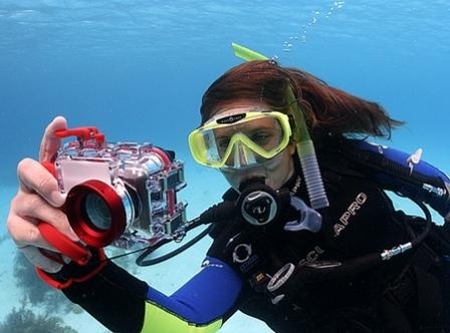
With the floods that we have had recently, there is probably more than one
camera that went swimming, and is now (hopefully) the subject of an insurance
claim. However, there is truly another world beneath the surface.
A few years back, one of our avid underwater explorers wrote
and suggested I should write on this subject. What he did not know, being a
weekend flipper and snorkel type as he was, is that I get nervous if the water
reaches my knees. Many years ago I struck a bargain with sharks, those denizens
of the deep with the amazing dentition. The deal was that I would not swim in
their bath water, if they would refrain from swimming in mine. I have been true
to my word, and they have also, with no dorsal fins seen anywhere near my bath
tub. So because of my fear, my knowledge of underwater photography is restricted
to shooting through the portholes of swimming pools!
I actually did a camera test many years ago on the
ferociously expensive Nikonos cameras. It was easy to clean - you just directed
the garden hose at it, and all the sand washed off (after I had bravely put it
under the surface and photographed the model’s feet).
However, with the advent of cheap underwater cameras these
days (even disposable ones), you do not have to invest in a Nikonos to try
getting a few shots beneath the surface.
Now comes the technical stuff. Not only can you not breathe
sea water, what has to be remembered is that water (especially sea water), is
700 times more dense and 2000 times less transparent than air. Even though it
may look crystal clear down there with the dugongs, it is not. It has been
suggested to me that if you are using natural light (that is from the sun above
the waves) then do not go lower than seven meters below the surface. That is
five meters deeper than I am high - that definitely precludes my trying it.
For these reasons, underwater photographers will use wide
angle lenses, so that they have to be close to the subject, so there is then
less water between the camera and the item being photographed. If it is a large
fish with teeth, you need to be a knee tremblingly three meters from it, to get
a good shot. Far too close for me! Those that claim to know (and I do know a
couple of underwater photographers who so far have neither been eaten or
drowned) say that a focal length lens of between 28 mm and 15 mm (almost a ‘fish
eye’) would be appropriate for 35 mm cameras.
Another tip given to me by the wet-suit and water-wings
brigade is to take the meter reading on the surface and open up the aperture one
f stop for every three meters depth.
Again when using sunlight, the best time of day is the exact
opposite from the above the surface shooter. Forget early morning and late
afternoon, as the sun’s rays get reflected away from the surface of the water.
The best time is when the sun is directly overhead and the light penetrates the
water more easily.
You may have also noticed that underwater shots can have
strange colors. This is because the light becomes diffused as it travels through
the water, and the different colors, which have different wavelengths, become
absorbed at different rates (or depths). Red is the first to go and yellow is
the last. The predominant color is then usually bluish or greenish, which
explains why underwater shots have that color cast. You can counteract this by
manipulation in the computer with your electronic paint brush.
However, whatever the technicalities, if you just want to try
something different one weekend, buy one of the inexpensive throw-away
waterproof cameras, stay just under the surface and see what you get. You will
probably be delighted with the results. But if you are considering SCUBA diving
with a spear gun in one hand and a camera in the other, you will need much more
specialized equipment! Glug, glug.

